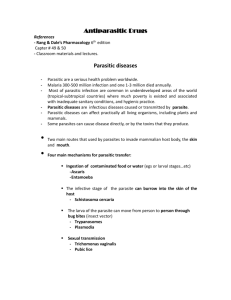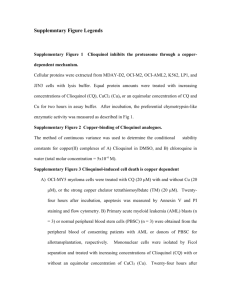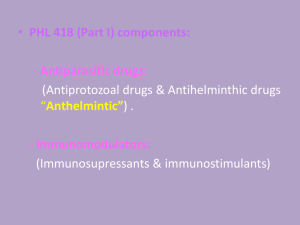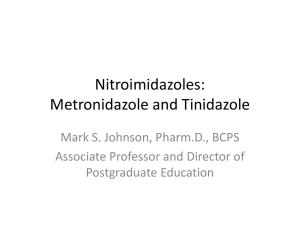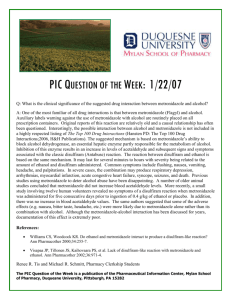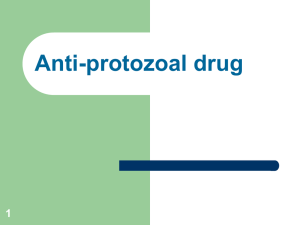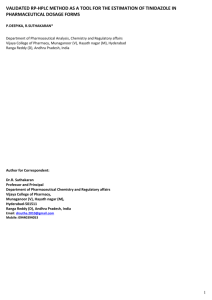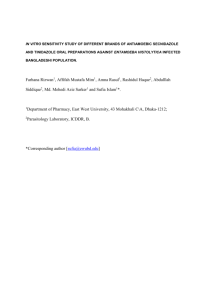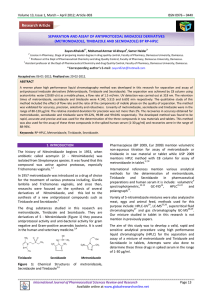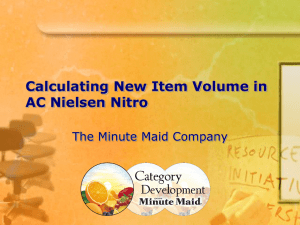Antiprotozoal agents
advertisement
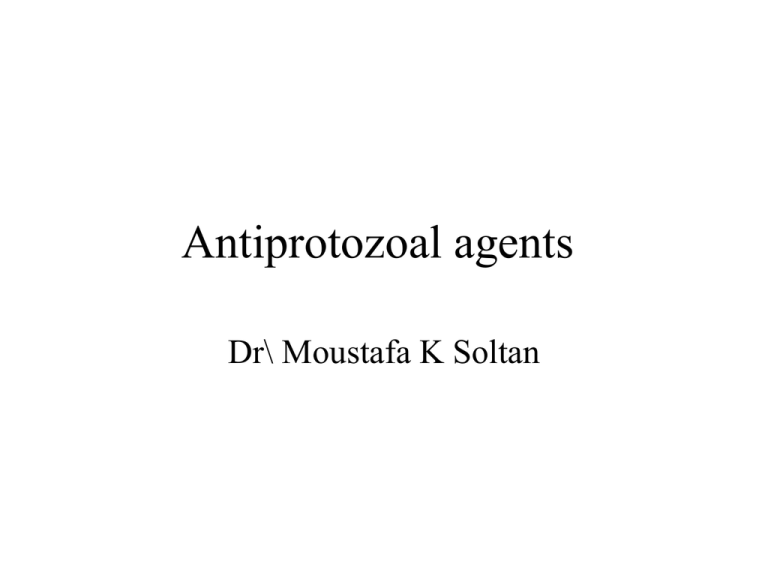
Antiprotozoal agents
Dr\ Moustafa K Soltan
Classification of Antiprotozoal agents.
antiparastic
antiprotozoal
anthelmintics
unicellular parasites
multicellular parasites
.
Protzoal infections may be one or more infection results from the following:
1) amoebiasis.
2) trichomoniasis.
3) girdiasis.
4) leishmaniasis.
5) trypanosomiasis. 6) malaria. 7) toxoplasmosis.
Classification of antiprotozoal infections:
I] Antiamoebic drugs. For treatment of Entamoeba histolytica infections.
Tissue amoebicides (hepatic amoebiasis ) Extraintestinal amoebicides
Act in extraintestinal tissues, in liver, bowel wall
they include: nitroimmidazole. : metronidazole, tinidazole , secnidazole.
chloroquine: antimalarial
emetine, dehydroemetine
antibiotic amoebicides: paromomycin
luminal amoebicides :intestinal amoebicides.
act in bowel lumen (intestine)
they include:
halogenated 8-hydroxy quinoline: Chiniofon, clioquinol, iodoquinol.
dichloroacetamide derivatives: diloxanide furoate
organoarsenicals: carbarsone.
II] Antitrichomonal and antigiardial agents are some antiamoebic
agents…….
III] Antileishmanial drugs: 1) antimonial drugs: sodium stipogluconate.
2) diamidines: pentamidine isothionate.
IV] Antitrypanosomal drugs: (trypanocides)
1) 5-nitrofuran derivatives: nifurtimox
2) urea derivatives: suramin sodium.
V] antimalarial drugs.
1) Nitroimmidazole. metronidazole
2-methyl-5-nitro-1-(2-hydroxyethyl) immidazole..
Or
2-(2-methyl-5-nitro-1-immidazolyl) ethanol.
Tinidazole =
2-methyl-5-nitro-1-[2-(2-ethylsulfonyl) ethyl] immidazole.
Secnidazole:
2-methyl-5-nitro-1-(2-hydroxypropyl)- immidazole. (or)
1-(2-methyl-5-nitro-1-immidazolyl)-2-hydroxypropane.
O 2N
H
N
CH
3
N
HNO3
H 2S O 4
H
N
CH
N
1
3
CHO
-H 2 O
CHO
2
1 CH 2 CH 2 OH
Cl C H 2 CH 2 OH
2-chloroethanol
O 2 N 5 N 2 CH
G lyoxal
CH 2 CH 2 OSO 2 Et
O 2N
3
4
N3
M etronidazole
+ 2N H 3 + C H 3 C H O
acetaldehyde
Et S O 2 C l
N
CH
N
tinidazole
3
selectivity of nitro group containing antibacterial, antiamoebic,
antitrypanosomal arises from absence of nitroreudctase in human and
presence of it in the invading organism.
2) so we can say that in metronidazole, tinidazole, secnidazole, nitro group
cause both the activity and selectivity.
3) advantages of tinidazole and secnidazole over metronidazole
1) less incidence of side effects.
2) administered single dose daily for 4 days due to high T1/2, while
metronidazole 7-10 days.
Mechanism of action. Reduction of nitro group by nitroreductase enzyme
to unstable, cytotoxic intermediate, interact with DNA prevent further
replication so death.* so we can say nitro group is essential for activity.
Uses.
1) Intestinal and extraintestinal antiamoebic.
2)antitrichomonal,antigiardial,antileishmanial
3)anaerobic bacteria cause septicemia.*tinidazole has fewer side effects
than metronidazole.
2) halogenated 8-hydroxy quinoline
Chiniofon :Sodium salt of 7-iodo-8-hydroxuquinoline-5-sulfonate
H2 SO 4
1)KI / CaOCl2
2)Na2 CO3
Chiniofon
Iodoquinol :5,7-diiodo-8-hydroxyquinoline
KI / KOCl
START FROM SKRAUP
SYNTHESIS
oxine
iodoquinol
Skraup synthesis of quinoline ring: begin from it when asked in synthesis of
halogenated 8-hydroxy quinoline derivatives: ( chiniofon, iodoquinol begin from
oxine) ( clioquinol begin from 5-chlorooxine)
conc H2SO4
FeSO4
Nitrobenzene
conc H2SO4
FeSO4
Nitrobenzene
glecyrol
oxine
5-chlorooxine
role of conc. H2SO4: Converting glycerol into acrolien which react with oaminophenol.
We can not use acrolein directly as it is toxic compound.
role of nitrobenzene: oxidation of 1,2-dihydroquinoline to quinoline ring and
reduced to aniline.
role of ferrous sulfate: preventing explosion of the reaction.
Clioquinol : 5-chloro-7-iodo-8-hydroxyquinoline
KI / KOCl
START FROM SKRAUP
SYNTHESIS
5-chlorooxine
clioquinol
3) dichloroacetamide derivatives
Diloxanide furoate :4-(2,2-dichloro-N-methylacetamido)phenyl-2-furoate
CH
HO
NH
H
3
O
C
+
C
N aC N
C atalyst
Cl
p-m ethylam ino Cl
Cl
phenol.
chloral
CH
O
O
O
N
3
1
C
O
CH
+
N
HO
H
Cl
Cl
H
Cl
-
O
Cl
C
C Cl
H
Cl
-H Cl
O
2
3
O
2-furoyl chloride
-H C l
rearrangem ent
CH
HO
N
Cl
3
C
C
O
H
Cl
Mechanism of action
Chelating properties of 8-hydroxyquinoline which bind ferrous atom inside cell
Uses:
1)intestinal amoebiasis but cause neurotoxicity.
2) antibacterial, antifungal activity so in skin diseases like dermatitis, eczema,
psoriasis (Clioquinol)
Uses of Diloxanide
intestinal amoebiasis, drug of choice in case of asymptomatic amoebiasis
(carriers)
4) organoarsenicals
Carbarsone :4-ureido-1-phenyl arsonic acid
or
4-carbamoyl amino phenyl arsonic acid
or
N-carbamoyl arsanilic acid. Or p-uriedobenzene arsonic acid.
O
NH
NH
2
2
H 3 As O 4
arsenic acid
direct
As OH
arsonation HO
O
arsanilic acid
HN
1) urethane
H 2 NC OOC 2 H 5
OR 2) NaNCO
CH 3 C OOH
HO
As
NH
2
OH
O
carbarsone
As+5 is reduced to As+3 which interact with thiol Group of enzymes present in the
parasite through complexation reaction leading to death. It acts on trophozite phase
of Entamoeba.
Used in intestinal amoebiasis.
Assay
conc H 2 S O 4
non volatile arsenic oxide A s 2 O 3
F um ing H N O 3
H 2O
reduction by boiling
w ith K I
I2
+ H 3 A sO 3
H 3 A sO 4 A rsenic acid
A rsenous acid
** R X N is reversilbe shift to left (com pletion) in acid and iodine is
expelled, rem ainder is reduced by sod.thiosulfate till no iodine color.
** m edia is m ade alkaline by N aH C O 3 .
** A rsenous acid is directly determ ined by titration w ith st I2 ,
using starch as indicator. H As O
I +H O
H
AsO + 2H I
**w eighed sam ple
3
3+
2
2
3
4
Antileishmanial drugs.
Sodium
Stipogluconate:
Antimony sodium Gluconate.
freshly prepared conc soln
A lkali
+
S
b
O
2 5
of gluconic acid
sod stipgluconate
Pentamidine
Isothionate. ** 4,4- -(pentamethylenedioxy) dibenzamidino-bis- (2hydroxyethanesulfonate).
**
p-aminophenol
diazotization
) NaNO / HCl
)CuCN / KCN
P-hydroxybenzonitrile
NaOEt
sandmayer rxn
**
, -dibromopentane
NaOEt
dinitrile
unhydrous EtOH
Dry HCl
Pinner rxn
addn on CN
gp
Cl-
NH
HO-CH -CH -SO H
Pentamidine isothionate
Sod stipgluconate Sb+5 is reduced to Sb+3 which inhibit phosphofructokinase
enzyme in parasite
Drug of choice in treatment of leishmania
Pentamidine isothionate
1) interact with DNA resulting in inhibition of DNA, RNA and protein
synthesis.2)interfere with polyamine uptake due to structure similarity.
1)alternative for visceral leishmaniasis.
2)2ry agent in treatment, prophylaxis against African trypanosomiasis.
Antitrypanosomal.
Nifurtimox: 4-[(5-nitrofufurylidene)amino]-3-methylthiomorpholine1,1-dioxidex :
condensationn
5-Nitro-2-furaldehyde
4-amino-3-methyl
tetrahydro-1,4-thiazine-1,1-dioxide
nifurtimox
Suramin sodium :Hexasodium carbonyl-bis-{8-[3-(3aminobenzamido)-4-methylbenzamido] Naphthalene-1,3,5-trisulfonate}
1
2 1
3
8
4
5
7
6
4
2 3
1
2
3
2
Uses
South American trypanosomiasis which is called ( chagas disease) caused by
Trypanosome cruzi (in early stage)
12) mode of action of nifurtomox:
1)nitro group converted into chemically reactive free radical intermediates react with several cell
components cause lethal effect.
a] nitro anion radical metabolite which react with DNA cause lethal effect.
nitroreductase enzyme
B] superoxide anion.
C] hydrogen peroxide.
non enzyme rxn
superoxide dismutase
2) mammalian cells have several defense enzymes like catalase, peroxidase, and superoxide dismutase
which prevent lethal effect. while parasite lack such enzymes (selective toxicity).
Suramin sodium
Inhibit various trypanosomal enzymes such as
Glycerol-3-phosphate oxidase, so block glycolysis in parasite which depend on
glycolysis for energy production so death.
Drug of choice in the prophylaxis against African trypanosomiasis in early stages
